climate change on UAE - Stockholm Environment Institute-US Center
climate change on UAE - Stockholm Environment Institute-US Center
climate change on UAE - Stockholm Environment Institute-US Center
You also want an ePaper? Increase the reach of your titles
YUMPU automatically turns print PDFs into web optimized ePapers that Google loves.
groundwater available, excluding an assumed<br />
fresh groundwater source in the western<br />
regi<strong>on</strong> of the country, near Liwa and Madinat<br />
Zayed. This number is higher than the estimate<br />
reported in Table 2.1, but research by GTZ<br />
suggests a substantial freshwater lens in the<br />
western regi<strong>on</strong> that is partially taken to account<br />
here. Future analysis could, of course, modify<br />
this assumpti<strong>on</strong>. Brooks et al. note that “the<br />
GWRP calculated a total groundwater reserve<br />
of 253 Km³ (7% fresh, 93% brackish) and the<br />
GWAP total estimate of 640 Km³ (2.6 % fresh,<br />
18.1 % brackish, 79.4% saline) is much larger<br />
since groundwater of salinity of up to 100,000<br />
mg/l TDS was included, whereas the GWRP<br />
included groundwater with less than 15,000<br />
mg/l TDS”. The GWRP assessment (<strong>US</strong>GS,<br />
1996) projects that the fresh and brackish<br />
groundwater resources will be depleted in 50<br />
years at current groundwater abstracti<strong>on</strong> rates.<br />
Their analysis does not include the freshwater<br />
sources in the western regi<strong>on</strong>. Given our initial<br />
estimate of fresh and brackish groundwater,<br />
these resources would be depleted in about<br />
150 years given current extracti<strong>on</strong> rate from<br />
the agriculture and forestry sectors of about<br />
2,500 Mm 3 /year. This variance highlights the<br />
importance of the assumpti<strong>on</strong>s regarding the<br />
current fresh and brackish groundwater supplies<br />
in determining their l<strong>on</strong>g-term availability.<br />
Figure 5‐5 shows the total storage of the<br />
fresh and brackish groundwater for the three<br />
Optimistic Scenarios. In the analysis, <strong>on</strong>ly the<br />
agriculture and forestry sectors are depending<br />
<strong>on</strong> groundwater as their supply source.<br />
Interestingly, the relative difference between<br />
the Optimistic Scenario with adaptati<strong>on</strong> and No<br />
Climate <str<strong>on</strong>g>change</str<strong>on</strong>g> (1.1) and the same Scenario that<br />
assumes no <str<strong>on</strong>g>climate</str<strong>on</strong>g> <str<strong>on</strong>g>change</str<strong>on</strong>g> (1.2) are <strong>on</strong>ly slightly<br />
different, suggesting the marginal impact that<br />
<str<strong>on</strong>g>climate</str<strong>on</strong>g> <str<strong>on</strong>g>change</str<strong>on</strong>g> would have <strong>on</strong> groundwater<br />
resources. The Optimistic Scenarios (1) does<br />
not include any reducti<strong>on</strong>s in agriculture or<br />
forestry demand over the study horiz<strong>on</strong> and also<br />
imposes the moderate <str<strong>on</strong>g>climate</str<strong>on</strong>g> <str<strong>on</strong>g>change</str<strong>on</strong>g> forcing.<br />
However, as was just stated, the relative impact<br />
of <str<strong>on</strong>g>climate</str<strong>on</strong>g> <str<strong>on</strong>g>change</str<strong>on</strong>g> <strong>on</strong> groundwater storage is<br />
quite small, so all of the decline in groundwater<br />
storage is attributable to the c<strong>on</strong>tinued high<br />
demand from the agricultural and forestry<br />
sectors. Since the Pessimistic Scenario is really<br />
<strong>on</strong>ly c<strong>on</strong>cerned with growth in the urban sector,<br />
the groundwater storage results for all three<br />
of those Scenarios are nearly identical to the<br />
Optimistic Scenarios results just presented.<br />
5.4. Adaptati<strong>on</strong> and Mitigati<strong>on</strong> to<br />
Climate Change: Hand-in-Hand<br />
The analysis just presented suggests the likely<br />
range that <str<strong>on</strong>g>climate</str<strong>on</strong>g> <str<strong>on</strong>g>change</str<strong>on</strong>g> and other socioec<strong>on</strong>omic<br />
factors will have <strong>on</strong> the water supplydemand<br />
balance in the ADE. Given the current<br />
state-of-the science with regards to future<br />
<str<strong>on</strong>g>climate</str<strong>on</strong>g>, the analysis reports assumpti<strong>on</strong>s<br />
about future per-capita demand and populati<strong>on</strong><br />
growth, and the priorities and policies associated<br />
with agricultural producti<strong>on</strong> and development<br />
will overwhelm the impacts of <str<strong>on</strong>g>climate</str<strong>on</strong>g> <str<strong>on</strong>g>change</str<strong>on</strong>g><br />
<strong>on</strong> the water resources sector. While this likely<br />
the case, the analysis drives home the point<br />
that serious c<strong>on</strong>siderati<strong>on</strong> should be given to<br />
the l<strong>on</strong>g-term goals and sustainability of the<br />
agriculture and forestry sectors. If these sectors<br />
c<strong>on</strong>tinue to use water at their current rate,<br />
they will c<strong>on</strong>tinue to strain a limited resource.<br />
Climate <str<strong>on</strong>g>change</str<strong>on</strong>g> will <strong>on</strong>ly hasten that positi<strong>on</strong>.<br />
On the M&I side, “if freshwater supply has<br />
to be replaced by desalinated water due to<br />
<str<strong>on</strong>g>climate</str<strong>on</strong>g> <str<strong>on</strong>g>change</str<strong>on</strong>g>, then the cost of <str<strong>on</strong>g>climate</str<strong>on</strong>g> <str<strong>on</strong>g>change</str<strong>on</strong>g><br />
includes the average cost of desalinati<strong>on</strong>, which<br />
is currently around <strong>US</strong>$1.00/m 3 for seawater and<br />
<strong>US</strong>$0.60/m3 for brackish water (Zhou and Tol,<br />
2005). The cost for freshwater chlorinati<strong>on</strong> is<br />
approximately <strong>US</strong>$0.02/m 3 ” (IPCC SRES, 2008).<br />
Water c<strong>on</strong>servati<strong>on</strong> will be needed to avoid the<br />
c<strong>on</strong>tinued expansi<strong>on</strong> of desalinizati<strong>on</strong> capacity,<br />
since increased dependence <strong>on</strong> desalinized<br />
water is sub-optimal.<br />
Increasing desalinizati<strong>on</strong> capacity would seem<br />
to be a quick and easy adaptati<strong>on</strong> to future<br />
demand, but it does not come without a cost from<br />
both a financial and envir<strong>on</strong>mental perspective.<br />
Increasing, to achieve water resource reliability,<br />
the water resources management strategy has<br />
essentially been in investing in more energy<br />
to produce more water. But this opti<strong>on</strong> must<br />
acknowledge that desalinizati<strong>on</strong> and the<br />
distributi<strong>on</strong> of water accounts for a significant<br />
share of total energy c<strong>on</strong>sumpti<strong>on</strong>, as power<br />
plant emissi<strong>on</strong>s account for a significant share<br />
of Green House Gases (GHGs). Desalinizati<strong>on</strong><br />
is not a “Green” soluti<strong>on</strong>. Moreover, the latest<br />
122<br />
Climate Change Impacts, Vulnerability & Adaptati<strong>on</strong>










